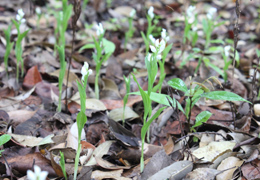Initiatives for Biodiversity
The Group’s Basic Environmental Management Policy and the Mid-term Environmental Management Policy stipulate that business activities must consider biodiversity and ecosystem services. The Group has established the Basic Biodiversity Principles and Action Guidelines based on these policies. When this was established, the Group surveyed its initiatives on biodiversity, the use of natural resources, and status of efforts to comply with the Cartagena Protocol both inside and outside of Japan. Additionally, the Group assessed the relationship between its business activities and biodiversity and identified issues through an analysis of the Group’s risks and opportunities. (Please refer to the diagram “Map of corporate activities and biodiversity” below.)
The Daiichi Sankyo Group believes that biodiversity conservation and sustainable use of ecosystem services are essential in performing business. We promote raising awareness and understanding of employees, as well as the strengthening of environmental conservation activities in collaboration with business partners and private groups, to procure materials with less environmental burden, and to socially contribute towards biodiversity conservation.
Basic Biodiversity Principles and Action Guidelines
Basic Policy
- Our Basic Environmental Management Policy states that, “Safeguarding the environment is the bedrock of all Group operational management.” We have
therefore acted to prevent pollution and global warming and contribute to recycling. Through our initiatives, we have used biological resources properly to
minimize the impacts of our operations on biodiversity and have sustainably reduced chemical and other discharges.
- We will continue striving to preserve biodiversity and respect the principles of the Convention on Biological Diversity by adhering to the following
Biodiversity Action Guidelines, thereby enhancing social sustainability.
Action Guidance
1.
Actively promote to address biodiversity conservation in all business activity |
- Under take ongoing endeavors to avoid or reduce operational impacts on biodiversity, devoting particular attention to lowering the environmental impacts of air and water emissions and wastes.
|
2.
Identify the biodiversity impacts of ecosystem services, using those services sustainably |
- Recognize the operational importance of ecosystem services while understanding and minimizing their impacts on biodiversity, using those services sustainably.
|
3.
Use genetically modified organisms responsibly |
- Maintain biosafety by continuing to responsibly use genetically modified organisms in drug discovery and production in keeping with the Cartagena Protocol on Biosafety and national laws and ordinances.
|
4.
Access to Genetic Resources and the Fair and Equitable Sharing of Benefits Arising from their Utilization |
- Comply with the Convention on Biological Diversity, the Bonn Guidelines, and other relevant rules to access and utilize genetic resources of the provider countries appropriately and to share benefits arising from their utilization in a fair and equitable manner.
|
5.
Communicate with stakeholders and improve in-house awareness |
- Foster biodiversity preservation by communicating and liaising better with public and private entities.
- Educate employees to better understand how operations affect biodiversity and encourage internal and external efforts to safeguard biodiversity.
|
Map of Corporate Activities and Biodiversity

An enlargeable image opens in a separate window
TNFD Disclosure
The Daiichi Sankyo Group believes that the conservation of biodiversity and the sustainable use of ecosystem services are essential in performing business. We therefore promote biodiversity initiatives to achieve the Nature Positive*1.
We agree with the TNFD*2 recommendations and registered as a TNFD Adopter*3 in May 2024. We recently conducted a general assessment of nature-related risks in our supply chain for our main products, extracted material risks, and conducted locational analysis.
*1Nature Positive is a global societal goal defined as ‘Halt and reverse nature loss by 2030 on a 2020 baseline, and achieve full recovery by 2050 for the benefit of people and planet
*2TNFD(Taskforce on Nature-related Financial Disclosures): The TNFD is a market-led, science-based and government-supported global initiative. The recommendations and guidance provide organisations with a risk management and disclosure framework to act on evolving nature-related dependencies, impacts, risks and opportunities. They are designed to provide decision-useful information to capital providers and other stakeholders./
*3TNFD Adopter:organisations that have committed to start making disclosures aligned with the TNFD Recommendations in their corporate reporting for their fiscal years 2023, 2024 or 2025.
Governance
In general our corporate activities, we strive to protect the environment and ensure health and safety, contributing to a sustainable society. At the same time, we also work to operate and promote Environment, Health, and Safety Management in areas where risks are likely to materialize. To that end, we have established an EHS Management Committee, chaired by the Chief Executive Officer of EHS Management. Committee meetings are held twice a year to discuss and report on policies, goal setting, and company activities related to global EHS Management. The EHS Management Committee reports significant matters to the Daiichi Sankyo Board of Directors for supervision.
Corporate Governance Code
Environmental Management Promotion System
The Daiichi Sankyo Group has established EHS Policy and has implemented EHS initiatives based on the recognition that protecting the environment and ensuring the health and safety of our employees throughout every aspect of its corporate activities constitutes key management issues. Additionally, our Biodiversity Basic Policy and Action Guidelines stipulate “Access to Genetic Resources and the Fair and Equitable Sharing of Benefits Arising from their Utilization” and “Communicate with stakeholders and improve in-house awareness”. Furthermore, the Daiichi Sankyo Group Human Rights Policy declares that the Group respects international norms and principles, and as a signatory of the United Nations Global Compact, supports the 10 principles in the four areas of human rights, labor, environment, and anti-corruption
Daiichi Sankyo Group EHS Policy
Biodiversity Basic Policy and Action Guidelines
Daiichi Sankyo Group Human Rights Policy
Risk & impact management
Our processes for identifying, assessing and prioritising nature-related dependencies, impacts, risks and opportunities
We identified and assessed dependencies and impacts related to nature, and risks and opportunities through the following process. To understand nature-related issues in our supply chain, we assessed dependencies and impacts in the pharmaceutical sector and sectors related to upstream and downstream using the risk assessment tool ENCORE. With regards to the risks identified through this analysis that have significant dependencies and impacts, we conducted a survey of risk cases and assessed the magnitude of impact that these risk cases could have on our business short-, medium-, and long-term from the perspective of their severity. Based on these two results, we have identified material risks for our Group.
For material risks, we conducted a locational analysis for each risk item using the risk assessment tool to assess the possibility of these risks manifesting in locations in which we operate. Based on these results, we identified areas where our business should prioritise future efforts. The locational analysis was conducted based on the current natural state, and we plan to conduct medium- to long-term assessments after we establish a TNFD scenario analysis methodology.
Regarding countermeasures, we plan to consider setting additional targets and implementing additional measures while continuing to conduct gap analysis and communicate with related parties.
Specific results of these are explained in the Strategy section.

Our Identification & Assessment Process for Nature-Related Dependencies, Impacts, Risks, and Opportunities
Our processes for managing nature-related dependencies, impacts, risks and opportunities / Our overall risk management processes
The EHS Management Committee plays an important role in assessing and managing the impacts of nature-related risks, including climate change, and the risks and opportunities they present to our business, thereby enhancing our resilience. The Committee implements countermeasures against risks that may force changes in our business activities, such as climate change and water-related risks, and reports any significant risk concerns to the Board of Directors, where they are integrated into our comprehensive enterprise risk management. In addition, the Committee deliberates and decides on medium- and short-term targets and implementation plans aimed at transitioning to long-term carbon neutrality and the Nature Positive goals.
Strategy
Nature-related material risks and opportunities
Nature-related business risks are manifesting worldwide, and given their importance, we recognise that they are risk management issues that must be addressed in our business area, the pharmaceutical sector. We have analysed nature-related risks and opportunities that are of great interest to our stakeholders and closely related to our business following the LEAP approach advocated by the TNFD.
This analysis identifies nature-related material risks in our value chain, both in terms of dependencies and impacts on nature, and assesses locations and bases in our value chain where material risks are likely to manifest. Five major raw materials in our upstream supply chain were selected as targets in the risk case survey and locational analysis. The selection of these items is based on the condition that they are used in the targeted main products (sales coverage in FY2023: approx. 61%) and are listed on the SBTN High Impact Commodity List. Therefore, we recognize that there is still room for improvement in both, the scope of coverage and accuracy.
We believe that, going forward, it is important to specifically consider countermeasures to address the identified material risks to mitigate nature-related risks through operations in the identified locations and bases, as well as to expand opportunities, thereby enhancing our resilience.
- Identification of nature-related dependencies and impacts
We used the nature risk assessment tool (ENCORE) to assess nature-related dependencies and impacts relationships throughout the value chain and created a heat map.
Potential Risks by Material Issue
Assessment Results by Related Sector (Impacts)
- Evaluation of material risks
We collected nature-related risk cases that have significant dependencies and impacts on our related sectors and assessed their materiality to our business.Then, we created a materiality map of nature-related issues, using the ENCORE assessment results as the vertical axis, “Relevance to the pharmaceutical sector”, and the risk case survey results as the horizontal axis, “Relevance to our own business”. As a result, we identified six material risks for our company: “Water use”, “Natural resource use”, “Water depletion”, “Water pollution”, “Soil pollution”, and “Impacts on local ecosystems”.
Nature-Related Materiality Map (left: Dependency, right: Impact)
Assessment Results by Related Sector (Dependencies)
- Locational analysis of value chain
In order to assess the possibility of risks manifesting in locations in which we operate, we classified the identified material risks into three categories of “water resources”, “pollution”, and “ecosystems”, and conducted a locational analysis*4 for each risk item using a risk assessment tool. As a result, eight of our company's bases were identified as critical bases.
For the upstream of the value chain, we conducted a risk analysis of the main production areas of five major raw materials and confirmed that all of the raw materials are closely related to the material risks.
*4Assessment Indicators: water stress, water pollution index, presence or absence of mangroves and coral reefs, conflict cases, protected areas and areas undergoing deforestation, presence or absence of peat lands, Tool Names:Global Forest Watch、IBAT、Environmental Justice Atlas、Crop Production Maps、Global Wetlands、Global Dam Watch、WWF Water Risk Filter、Aqueduct、Ocean+ Habitat

Analysis Process for “Water Resources” (Direct Operations)

Analysis Process for “Pollution and Ecosystems” (Direct Operations)
Locational analysis Results (Direct Operations)
- Consideration of countermeasures
Examples of our Group's initiatives to address material risks are shown below. We plan to consider setting additional goals and implementing additional measures while continuing to conduct gap analysis and communicate with related parties.
Examples of Our Group's Initiatives to Address Material Risks
Metrics & targets
Quantitative Metrics
Quantitative environment-related data is disclosed in ESG Data. We will consider disclosure of core disclosure metrics by collecting data and conducting more detailed analysis.
Quantitative Targets
Our Group aims to achieve our environmental targets in order to contribute to the realization of Nature Positive goals.Quantitative environmental targets are disclosed in Promoting Environmental Management. In the future, we plan to consider the necessity to set additional targets based on TNFD recommendations.
Future Plans
Going forward, we plan to expand the scope of analysis, scrutinize suppliers, and conduct scenario analysis to enhance the sophistication of our analyses. In addition, we plan to consider setting additional targets and implementing additional countermeasures based on the results of gap analysis and communication with related parties.
Ecological Footprint
We assess the ecological footprint (EF), an indicator of biodiversity, jointly with experts from the NGO Global Footprint Network, to examine all environmental burdens in the business activities of Group companies in Japan. The assessed EF is used as a comprehensive indicator of environmental burdens, including those related to biodiversity, by reviewing and monitoring long-term changes in the relationship between the reduction of environmental burdens and biodiversity conservation (trade-off) in the Group.
This initiative has been recognized as an action for achieving the Aichi Target (20 targets) that was adopted at COP10 (the 10th Meeting of the Conference of the Parties to the Convention on Biological Diversity in Nagoya) and has been registered on the Nijyu-Maru Project as well. In addition, it was introduced as an example of monitoring biodiversity in the Guidelines for Private Sector Engagement in Biodiversity (Second Edition) issued by the Ministry of the Environment of Japan.
Initiatives for Biodiversity Conservation
Conservation for rare species of plants
To preserve the golden orchid (designated as critically endangered Type II in the Japanese Ministry of the Environment’s Red Data Book) and the silver orchid, we have prohibited entry into the forested area of the property at the Tatebayashi Biopharmaceuticals Center where the plant naturally grows (approximately 1,000 m2). The continued conservation effort has been resulted in an increase in the population of the species and expansion of breeding range.

Golden orchid

Silver orchid
Greening in harmony with the surrounding environment
The Kitamoto Office of Daiichi Sankyo Biotech Co., Ltd. engages in environmental conservation that considers the surrounding natural environment and ecosystem and implements sound insulation and greening in harmony with the neighboring Kitamoto Nature Observation Park.
Recognized for its various diversity-friendly initiatives, the office was given the 7th Sainokuni Green Plan Award in 2015. The award is granted by Saitama Prefecture to facilities that have achieved excellent greening and sound maintenance.
The office continues to engage in environmental conservation through greening and other ecosystem protection measures.
Activities to nurture biodiversity
In recent years, the population of pollinators such as honey bees and butterflies has been on a decreasing trend around the world due to the effects of deforestation, agricultural chemicals, global warming, and other issues. At our Pfaffenhofen Plant in Germany, we cooperate with Pfaffenhofen in Bloom -an initiative started by the city of Pfaffenhofen aimed to increase the pollinator population- and we are actively working on encouragement of biodiversity on the plant premises. We are planting many flowers in the approximately 3,200 m2 area as an environment where honeybees and other insects can inhabit. In addition, in April of 2022, Daiichi Sankyo Europe (Munich, Germany), one of our overseas group companies, started planting one tree per every new IT device, and approximately200 trees had already been planted. To promote this initiative, the company has secured enough land in Germany to plant approximately 3,000 trees, thereby working on achieving the Sustainability IT.

Planting in the premises

Afforestation through sustainable IT
Participation in 30by30 Alliance for Biodiversity
The Daiichi Sankyo group participates in 30by30 Alliance for Biodiversity launched in April 2022 by the Ministry of the Environment of Japan. 30by30 is a goal that aims to conserve or protect at least 30% of land and sea by 2030, thereby contributing to the conservation of biodiversity. We will promote initiatives to contribute to 30by30, including the implementation of e-learning programs to raise employee awareness and understanding of biodiversity and the setting of targets for biodiversity conservation.
Participation in Keidanren Initiative for Biodiversity Conservation
The Daiichi Sankyo group has endorsed the "Keidanren Declaration for Biodiversity and Guideline*1" advocated by the Japan Business Federation and the Keidanren Committee on Nature Conservation, and have participated in the " Keidanren Initiative for Biodiversity Conservation*2" We will promote initiatives to contribute to transitioning nature positive world, including the analysis and disclosure in line with TNFD recommendations and the setting of targets for biodiversity conservation, the initiatives to contribute to 30by30, the implementation of programs to raise employee awareness and understanding of biodiversity.
*1Keidanren Declaration for Biodiversity and Guideline
https://www.keidanren.or.jp/en/policy/2023/082_proposal.html
*2Keidanren Initiative for Biodiversity Conservation
https://www.keidanren-biodiversity.jp/logo_en.php